A Review of Heartbeat Detection Systems for Automotive Applications
Abstract
:1. Introduction
- In advance, based on the experiences of the author, who was an engineer of an automotive manufacturer, and prior discussions with the manufacturer’s engineers, the type and measuring method of the heart rate detection system are summarized.
- We used google scholar to search for papers on the types and measurement methods we had identified and selected relatively new papers as the target of our investigation. In some cases, however, the papers were not disclosed due to patents or were not published as a paper because the heartbeat monitoring system is more about development than research. In such cases, the survey was conducted on the Web, and relatively new content was selected for the survey.
2. Trends in Research and Development
- Algorithms for high accuracy and steady measurement of heartbeat;
- In-vehicle heartbeat measuring systems focused on driving.
2.1. Research Trends in Algorithm Development
2.2. Research Trends in Heartbeat-Measuring Systems Applied to Drivers in Vehicles
2.2.1. Measurement by Wearable-Type Devices
2.2.2. Measurement by Nonwearable-Type Devices
- 1.
- Correction of the offset shift of I-Q Lissajous due to changes in the positional relationship with the surrounding metal objects.
- 2.
- Synchronous detection for detecting pulsation-period signals buried in external disturbances. A model pulse wave signal was generated by applying the feedback of the estimated pulse wave number. The difference between this signal and the pulsation signal after the adaptive filter processing was recorded. The adaptive filter coefficients were updated so that the mean-square deviation was minimized.
- 3.
- Removal of periodic artifacts, such as respiratory harmonics. The respiratory component was extracted from the Doppler angular velocity signal, and the harmonics were estimated. The signal was passed through an adaptive filter, the difference from the Doppler angular velocity signal was recorded, and the coefficients of the adaptive filter were updated to minimize the mean-square deviation.
- For the time being, in-vehicle devices or in-vehicle cameras are used for the detection of a heartbeat, and in-vehicle cameras are used for the detection of the driver’s facial expression.
- Smartwatches and the camera of the smartphone are used for detection of heartbeat, and the camera of the smartphone is also used for detection of driver’s facial expression after some issues such as recharging and connectivity are solved perfectly.
- However, as for the professional driver, in-vehicle devices or in-vehicle cameras are used for the detection of a heartbeat, and in-vehicle cameras are used for the detection of the driver’s facial expression because they are obliged from the viewpoint of labor management.
3. Proposal for the Autonomous Driving Era
4. Conclusions
Funding
Institutional Review Board Statement
Informed Consent Statement
Conflicts of Interest
References
- Bernie DeGroat, Traffic Deaths Considerable Compared with Leading Causes of Death. Available online: https://news.umich.edu/traffic-deaths-considerable-compared-with-leading-causes-of-death/ (accessed on 1 June 2021).
- Abc News, Driver Suffers “Sudden Cardiac Death” Before Mississippi School Bus Crash That Injured Students. Available online: https://abcnews.go.com/US/driver-suffers-sudden-cardiac-death-mississippi-school-bus/story?id=65520740/ (accessed on 1 June 2021).
- CNN, Driver Killed and Seven Children Hurt in Mississippi School Bus Crash. Available online: https://edition.cnn.com/2019/09/10/us/mississippi-school-bus-crash/index.html (accessed on 30 July 2021).
- CBS NEWS, School Bus Driver Killed, 8 Students Injured in Crash off Mississippi Highway. Available online: https://www.cbsnews.com/news/mississippi-school-bus-crash-school-driver-killed-8-students-injured-mississippi-highway-us-72-benton-county-today/ (accessed on 30 July 2021).
- U.S. NEWS, Two Students Hospitalized After Lee County School Bus Crash. Available online: https://www.usnews.com/news/best-states/mississippi/articles/2021-04-19/two-students-hospitalized-after-lee-county-school-bus-crash (accessed on 30 July 2021).
- NBCnews, School Bus Driver Dead, Eight Children Injured in Mississippi Rollover. Available online: https://www.nbcnews.com/news/us-news/school-bus-driver-dead-least-7-children-injured-mississippi-rollover-n1051991 (accessed on 31 July 2021).
- JIJI.com, Car Runs off the Road in Downtown Umeda. Available online: https://www.jiji.com/jc/d4?p=osk602&d=d4_ftcc (accessed on 6 June 2021). (In Japanese).
- The Japan Times, Two Dead, Nine Injured as Car Runs over Pedestrians on Sidewalk in Osaka. Available online: https://www.japantimes.co.jp/news/2016/02/25/national/two-dead-nine-injured-car-runs-pedestrians-sidewalk-osaka/ (accessed on 30 July 2021).
- The Japan Times, Driver in Deadly Osaka Pedestrian Ramming May Have Had Fatal Heart Issue. Available online: https://www.japantimes.co.jp/news/2016/02/26/national/crime-legal/driver-deadly-osaka-pedestrian-ramming-may-fatal-heart-issue/ (accessed on 30 July 2021).
- Kwon, S.; Jung, C.; Choi, T.; Oh, Y.; You, B. Autonomous Emergency Stop System. IEEE Intell. Veh. Symp. Proc. 2014, 444–449. [Google Scholar] [CrossRef]
- Takano, M.; Morimoto, K.; Takagi, M.; Oda, T.; Nishimura, N. Development of an Emergency Stop Assistant System. SAE Tech. Pap. 2019, 1025, 1. [Google Scholar] [CrossRef]
- LEXUS Homepage, LEXUS Safety Technology. Available online: https://www.lexus.com/safety (accessed on 7 July 2021).
- Subaru Homepage, Safety Preventive Safety: Eyesight. Available online: https://www.subaru.jp/levorg/levorg/safety/safety2_2 (accessed on 6 June 2021).
- Hino Motors Ltd. Hino Motors Develops World’s First Emergency Driving Stop System (EDSS) for Commercial Vehicles to Be Launched on the Hino S’ELEGA This Summer. Available online: https://www.hino-global.com/corp/news/2018/20180521.html (accessed on 31 July 2021).
- Mitsubishi Fuso Truck and Bus Corp. Mitsubishi Fuso Releases 2019 Model Year Aero Queen and Aero Ace Large Coach Buses. Available online: https://www.mitsubishi-fuso.com/news/2019/02/21/mitsubishi-fuso-releases-2019-model-year-aero-queen-and-aero-ace-large-coach-buses/ (accessed on 30 July 2021).
- Cadillac Homepage. Automatic Emergency Braking. Available online: https://my.cadillac.com/how-to-support/safety/automatic-emergency-braking#:~:text=Helps%20Alert%20and%20Assist%20You,at%20speeds%20below%2050%20mph. (accessed on 31 July 2021).
- BMW Group Homepage. Stopping Safely in an Emergency. Available online: https://www.press.bmwgroup.com/global/article/detail/T0022635EN/stopping-safely-in-an-emergency?language=en (accessed on 31 July 2021).
- Kelly Blue Book. How Mercedes-Benz Active Emergency Stop Assist Works. Available online: https://www.kbb.com/car-news/how-mercedes-benz-active-emergency-stop-assist/ (accessed on 31 July 2021).
- Audi MediaCenter. Driver Assistance Systems. Available online: https://www.audi-mediacenter.com/en/technology-lexicon-7180/driver-assistance-systems-7184 (accessed on 31 July 2021).
- Study Group on Analysis of Factors Affecting Traffic Accidents in the Automobile Transport Business, Automobile Bureau, Ministry of Land, Infrastructure, Transport and Tourism, Health Management Manual for Drivers of Commercial Vehicles. Available online: https://wwwtb.mlit.go.jp/tohoku/jg/manual_kenkoukannri.pdf (accessed on 6 June 2021). (In Japanese)
- Arakawa, T. Application of Machine Learning for Driver State Detection Technology. Automot. Technol. 2021. in press (In Japanese) [Google Scholar]
- Izumi, S. Development of Non-Contact Heart Rate Variability and Respiration Monitoring Technology Using Microwave Doppler Sensor for in-Vehicle Application, Research Paper Funded by Takata Foundation; Takata Foundation: Tokyo, Japan, 2008. (In Japanese) [Google Scholar]
- Shin, J.H.; Hwang, S.H.; Chang, M.H.; Park, K.S. Heart Rate Variability Analysis Using a Ballistocardiogram During Valsalva Manoeuvre and Post Exercise. Physiol. Meas. 2011, 32, 1239–1264. [Google Scholar] [CrossRef]
- Singh, J.P.; Larson, M.G.; O’Donnell, C.J.; Wilson, P.F.; Tsuji, H.; Lloyd-Jones, D.M.; Levy, D. Association of hyperglycemia with reduced heart rate variability (The Framingham Heart Study). Am. J. Cardiol. 2000, 86, 309–312. [Google Scholar] [CrossRef]
- Koivistoinen, T.; Junnila, S.; Värri, A.; Kööbi, T. A New Method for Measuring the Ballistocardiogram Using EMFi Sensors in a Normal Chair. In Proceedings of the 26th Annual International Conference of the IEEE Engineering in Medicine and Biology Society, San Francisco, CA, USA, 1–5 September 2004; pp. 2026–2029. [Google Scholar]
- Sidikova, M.; Martinek, R.; Kawala-Sterniuk, A.; Ladrova, M.; Jaros, R.; Danys, L.; Simonik, P. Vital Sign Monitoring in Car Seats Based on Electrocardiography, Ballistocardiography and Seismocardiography: A Review. Sensors 2020, 20, 5699. [Google Scholar] [CrossRef]
- ROHM Co. Ltd. Pulse Wave Sensor. Available online: https://www.rohm.co.jp/electronics-basics/sensors/sensor_what3 (accessed on 1 September 2021). (In Japanese).
- Ministry of Land, Infrastructure, Transport and Tourism. Project to Promote Support for Accident Prevention Measures. Available online: https://www.mlit.go.jp/jidosha/anzen/subcontents/jikoboushi2.html (accessed on 6 June 2021). (In Japanese)
- Ye, C.; Toyoda, K.; Ohtsuki, T. Robust Sparse Adaptive Algorithm for Non-Contact Heartbeat Detection with Doppler Radar. IEICE Tech. Rep. 2018, 117, 5–10. (In Japanese) [Google Scholar]
- Digital PR Platform, Project Olive, Fast and Accurate Detection of Heart Rate Peaks. Available online: https://digitalpr.jp/r/43145 (accessed on 30 May 2021). (In Japanese).
- Check Your Heart Rate on Apple Watch. Available online: https://support.apple.com/guide/watch/heart-rate-apda88aefe4c/watchos (accessed on 16 July 2021).
- Get Started with Your New E4 Wristband. Available online: https://www.empatica.com/get-started-e4 (accessed on 25 August 2021).
- Heart Rate Transfer Mode: How to Set and Use. Available online: https://support.garmin.com/ja-JP/?faq=8G7NCxDkuo6bUMb6YTY8j6 (accessed on 6 June 2021). (In Japanese).
- Fitbit, Fitbit Surge. Available online: https://www.fitbit.com/pl/shop/surge (accessed on 30 July 2021).
- Superwatches, Jawbone Smartwatches (UP, UP2, UP3, UP4). Available online: https://www.superwatches.com/jawbone-smartwatches/ (accessed on 30 July 2021).
- Monitor Your Heart Rate with Apple Watch. Available online: https://support.apple.com/en-us/HT204666 (accessed on 16 July 2021).
- Falter, M.; Budts, W.; Goetschalckx, K.; Cornelissen, V.; Buys, R. Accuracy of Apple Watch Measurements for heart rate and energy expenditure in patients with cardiovascular disease: Cross-Sectional Study. JMIR mHealth uHealth 2019, 7, e11889. [Google Scholar] [CrossRef] [PubMed]
- Schuurmans, A.A.; de Looff, P.; Nijhof, K.S.; Rosada, C.; Scholte, R.H.; Popma, A.; Otten, R. Validity of the Empatica E4 wristband to measure heart rate variability (HRV) parameters: A comparison to electrocardiography (ECG). J. Med. Syst. 2020, 44, 1–11. [Google Scholar] [CrossRef] [PubMed]
- Gillinov, S.; Etiwy, M.; Wang, R.; Blackburn, G.; Phelan, D.; Gillinov, A.M.; Houghtaling, P.; Javadikasgari, H.; Desai, M.Y. Variable accuracy of wearable heart rate monitors during aerobic exercise. Med. Sci. Sports Exerc. 2017, 49, 1697–1703. [Google Scholar] [CrossRef] [PubMed]
- Pai, A. Ford Puts the Brakes on Its Heart Rate Sensing Car Seat Project. Available online: https://www.mobihealthnews.com/43191/ford-puts-the-brakes-on-its-heart-rate-sensing-car-seat-project (accessed on 6 June 2021).
- WithUS. Helpo-Easy to Carry Your Daily Health with Your Smartphone! Available online: https://withus.easy-myshop.jp/c-item-detail?ic=A000000001 (accessed on 6 June 2021). (In Japanese).
- EPSON Homepage, PS-100. Available online: https://go-wellness.epson.com/sensing/en-US/pulsense/ (accessed on 31 July 2021).
- CYCPLUS Homepage, H1 Heart Rate Monitor Band. Available online: https://www.cycplus.com/products/cycplus-h1-heart-rate-monitor-band (accessed on 31 July 2021).
- Powrlabs Homepage, Powr Labs Armband Heart Rate Monitor (Ant+ & Bluetooth 4.0 Dualband). Available online: https://www.powr-labs.com/products/powr-labs%E2%84%A2-armband-heart-rate-monitor-ant-bluetooth-4-0-dualband (accessed on 31 July 2021).
- Arduino Homepage. Available online: https://www.arduino.cc/ (accessed on 31 July 2021).
- Raspberry pi Homepage, Teach, Learn, and Make with Raspberry Pi. Available online: https://www.raspberrypi.org/ (accessed on 31 July 2021).
- For Projects, Arduino Wearable Heart Rate Monitor. Available online: https://duino4projects.com/arduino-wearable-heart-rate-monitor/ (accessed on 31 July 2021).
- Adafruit Homepage, NeoPixel Ring—24 × 5050 RGB LED with Integrated Drivers. Available online: https://www.adafruit.com/product/1586 (accessed on 31 July 2021).
- Switchscience Homepage. Gravity: Heart Rate Monitor Sensor for Arduino. Available online: https://www.switch-science.com/catalog/5065/ (accessed on 31 July 2021).
- Goel, V.; Srivastava, S.; Pandit, D.; Tripathi, D.; Goel, P. Heart rate monitoring system using finger tip through IoT. Heart 2018, 5, 1114–1117. [Google Scholar]
- Sai, R.P.; Sunil, M.P. Non-invasive Heart Rate Measurement on Wrist Using IR LED with IoT Sync to Web Server. In Smart Intelligent Computing and Applications; Springer: Singapore, 2019; pp. 65–74. [Google Scholar]
- Kazi, S.S.; Bajantri, G.; Thite, T. Remote heart rate monitoring system using IoT. Tech. Sens. Heartb. Using IoT 2018, 5, 2956–2963. [Google Scholar]
- Jung, I.-H.; Kwee-Bo, S. Ring-Type Heart Rate Sensor and Monitoring System for Sensor Network Application. J. Fuzzy Locig Intell. Syst. 2007, 17, 619–625. [Google Scholar]
- Oura. Know Why You Feel How You Feel. Available online: https://ouraring.com/ (accessed on 16 July 2021).
- TheTOUCH, HB Ring. Available online: https://thetouchx.com/ (accessed on 30 July 2021).
- Fujitsu, Fujitsu. IoT Solution UBIQUITOUSWARE FEELythm. Available online: https://www.fujitsu.com/jp/solutions/business-technology/future-mobility-accelerator/feelythm/ (accessed on 6 June 2021). (In Japanese).
- Kasai, N.; Ogasawara, T.; Nakashima, H.; Tsukada, S. Development of Functional Textile “Hitoe”: Wearable Electrodes for Monitoring Human Vital Signals. IEICE Commun. Soc. Mag. 2017, 11, 17–23. (In Japanese) [Google Scholar] [CrossRef] [Green Version]
- Yanagidaira, M.; Yasushi, M. Development of Driver’s Condition Monitor. Pioneer R&D 2003, 13, 75–82. (In Japanese) [Google Scholar]
- Nakagawa, T.; Kawachi, T.; Futatsuyama, K.; Nishii, K. Monitoring the Physical Condition of Drivers as They Drive. Denso Tech. Rev. 2016, 21, 103–108. (In Japanese) [Google Scholar]
- Arakawa, T.; Sakakibara, N.; Kondo, S. Development of Non-Invasive Steering-Type Blood Pressure Sensor for Driver State Detection. Int. J. Innov. Comput. Inf. Control 2018, 14, 1301–1310. [Google Scholar]
- Essers, S.; Lisseman, J.; Ruck, H. Steering Wheel for Active Driver State Detection. Auto Tech Rev. 2016, 5, 36–41. [Google Scholar] [CrossRef]
- SAE International, SAE J3016 Levels of Driving Automation. Available online: https://www.sae.org/news/2019/01/sae-updates-j3016-automated-driving-graphic (accessed on 25 August 2021).
- Mitani, S. Development of the in-Vehicle Pulse Sensor. Omron Tech. 2019, 50, 1–6. [Google Scholar]
- Murata, K.; Fujita, E.; Kojima, S.; Maeda, S.; Ogura, Y.; Kamei, T.; Tsuji, T.; Kaneko, S.; Yoshizumi, M.; Suzuki, N. Noninvasive Biological Sensor System for Detection of Drunk Driving. IEEE Trans. Inf. Technol. Biomed. 2011, 15, 19–25. [Google Scholar] [CrossRef]
- Delta Kogyo Co. Ltd. Sleep Buster. Available online: http://mu-len.jp/kenkyu/index.html (accessed on 6 June 2021). (In Japanese).
- Ministry of Land, Infrastructure, Transport and Tourism. List of Devices Certified to Prevent Overworked Driving. Available online: https://www.mlit.go.jp/jidosha/anzen/subcontents/data/karoukiki-ichiran2.pdf (accessed on 6 June 2021). (In Japanese)
- Turpen, A. Researchers Develop a Heart Monitor for Your Driver’s Seat. Available online: https://newatlas.com/car-seat-ecg/40230/ (accessed on 13 June 2021).
- HARKEN. Available online: https://harken.ibv.org/index.php/about (accessed on 14 June 2021).
- TEXAS INSTRUMENTS. Using TI mmWave Sensors for Heart-Rate Monitoring. Available online: https://e2e.ti.com/blogs_/b/behind_the_wheel/posts/ti-mmwave-technology-for-car-interior-sensing (accessed on 30 July 2021).
- Arakawa, T.; Sakakibara, N.; Kondo, S. Development of an in-vehicle and continuous measurement blood pressure monitor using ultrasonic Doppler method. In Proceedings of the Institute of Industrial Applications Engineers, Kitakyushu, Japan, 22 September 2017. (In Japanese). [Google Scholar]
- Arakawa, T. Recent Research and Developing Trends of Wearable Sensors for Detecting Blood Pressure. Sensors 2018, 18, 2772. [Google Scholar] [CrossRef] [Green Version]
- Subaru Homepage. Subaru All-Around Safety. Available online: https://www.subaru-global.com/ebrochure/Forester/2020my/ISEN/safety/index.html (accessed on 31 July 2021).
- Toyota Homepage. Toyota Launches LS and Mirai Equipped with “Advanced Drive” that Enables Drivers and Cars to Drive Together in Japan. Available online: https://global.toyota/en/newsroom/corporate/35063150.html (accessed on 31 July 2021).
- Volvo Cars Global Newsroom. Driver monitoring camera in Volvo’s XC90 Drive Me car. Available online: https://www.media.volvocars.com/global/en-gb/media/photos/202070/driver-monitoring-camera-in-volvos-xc90-drive-me-car (accessed on 31 July 2021).
- Denso Homepage. Driver Status Monitior DN-DSM. Available online: http://design.denso.com/en/works/works_067.html (accessed on 31 July 2021).
- Nissan Homepage. ProPILOT 2.0 Driver Monitoring System Confirms the Driver is Attentive. Available online: https://global.nissannews.com/en/photos/photo-bafd61da591f6a12b9336e84540019ad-propilot-20-driver-monitoring-system-confirms-the-driver-is-attentive (accessed on 31 July 2021).
- The Verge. Tesla Starts Using in-Car Camera for Autopilot Driver Monitoring. Available online: https://www.theverge.com/2021/5/27/22457430/tesla-in-car-camera-driver-monitoring-system (accessed on 31 July 2021).
- Sakamaki, R.; Fujita, S. Heart Rate Estimation by Camera Images Using Skin Luminance Change. In Proceedings of the 82nd National Convention of IPSJ, Kanazawa, Japan, 5–7 March 2020; pp. 327–329. (In Japanese). [Google Scholar]
- Okada, G.; Yonezawa, T.; Kurita, K.; Tsumura, N. Monitoring Emotion by Remote Measurement of Physiological Signals Using an RGB Camera. ITE Trans. MTA 2018, 6, 131–137. [Google Scholar] [CrossRef] [Green Version]
- Kwon, S.; Kim, H.; Park, K.S. Validation of Heart Rate Extraction Using Video Imaging on a Built-In Camera System of a Smartphone. Annu. Int. Conf. IEEE. Eng. Med. Biol. Soc. 2012, 2174–2177. [Google Scholar] [CrossRef]
- Sun, G.; Negishi, T.; Kirimoto, T.; Matsui, T.; Abe, S. Noncontact Monitoring of Vital Signs with RGB and Infrared Camera and Its Application to Screening of Potential Infection, Non-Invasive Diagnostic Methods-Image Processing; IntechOpen: London, UK, 2018. [Google Scholar]
- CAC. Available online: https://www.cac.co.jp/product/rhythmiru/ (accessed on 28 June 2021). (In Japanese).
- Patel, S. Take a Pulse on Health and Wellness with Your Phone. Available online: https://blog.google/technology/health/take-pulse-health-and-wellness-your-phone/ (accessed on 28 June 2021).
- GSM. Fit Gets Heart Rate and Respiratory Rate Monitoring. Available online: https://www.gsmarena.com/google_fit_gets_heart_rate_and_respiratory_rate_monitoring-news-48107.php (accessed on 28 June 2021).
- Google Fit. Available online: https://www.google.com/fit/ (accessed on 28 June 2021).
- HRV4Training. Available online: https://www.hrv4training.com/ (accessed on 25 August 2021).
- Altini, M.; Berk, S.; Jansses, T.W.J. Heart rate variability during the first week of an altitude training camp is representative of individual training adaptation at the end of the camp in elite triathletes. Sport Perform. Sci. Rep. 2020, 125, 1–4. [Google Scholar]
- Williams, S.; Booton, T.; Watson, M.; Rowland, D.; Altini, M. Heart Rate Variability is a Moderating Factor in the Workload-Injury Relationship of Competitive CrossFit™Athletes. J. Sports Sci. Med. 2017, 16, 443–449. [Google Scholar] [PubMed]
- HRV4Training, The Ultimate Guide to Heartrate Variability. Available online: https://www.hrv4training.com/quickstart-guide.html (accessed on 25 August 2021).
- Huang, R.Y.; Dung, L.R. Measurement of Heart Rate Variability Using Off-the-Shelf Smart Phones. Biomed. Eng. OnLine 2016, 15, 11. [Google Scholar] [CrossRef] [Green Version]
- Statista. Global Smartphone Penetration Rate as Share of Population from 2016 to 2020. Available online: https://www.statista.com/statistics/203734/global-smartphone-penetration-per-capita-since-2005/ (accessed on 28 June 2021).
- BBC News, Nissan Launches Nismo Smartwatch for Drivers. Available online: https://www.bbc.com/news/technology-23964797 (accessed on 6 July 2021).
- Romero, D.; Bernus, P.; Noran, O.; Stahre, J.; Fast-Berglund, Å. The operator 4.0: Human cyber-physical systems & adaptive automation towards human-automation symbiosis work systems. In IFIP International Conference on Advances in Production Management Systems; Springer: Cham, Switzerland, 2016; pp. 677–686. [Google Scholar]
- Vanderhaegen, F.; Wolff, M.; Mollard, R. Non-conscious errors in the control of dynamic events synchronized with heartbeats: A new challenge for human reliability study. Saf. Sci. 2020, 129, 104814. [Google Scholar] [CrossRef]
- Dey, A.; Chen, H.; Zhuang, C.; Billinghurst, M.; Lindeman, R.W. Effects of sharing real-time multi-sensory heart rate feedback in different immersive collaborative virtual environments. In Proceedings of the IEEE International Symposium on Mixed and Augmented Reality (ISMAR), Munich, Germany, 16–20 October 2018; pp. 165–173. [Google Scholar]
- Vanderhaegen, F. Heuristic-based method for conflict discovery of shared control between humans and autonomous systems-A driving automation case study. Robot. Auton. Syst. 2021, 146, 103867. [Google Scholar] [CrossRef]
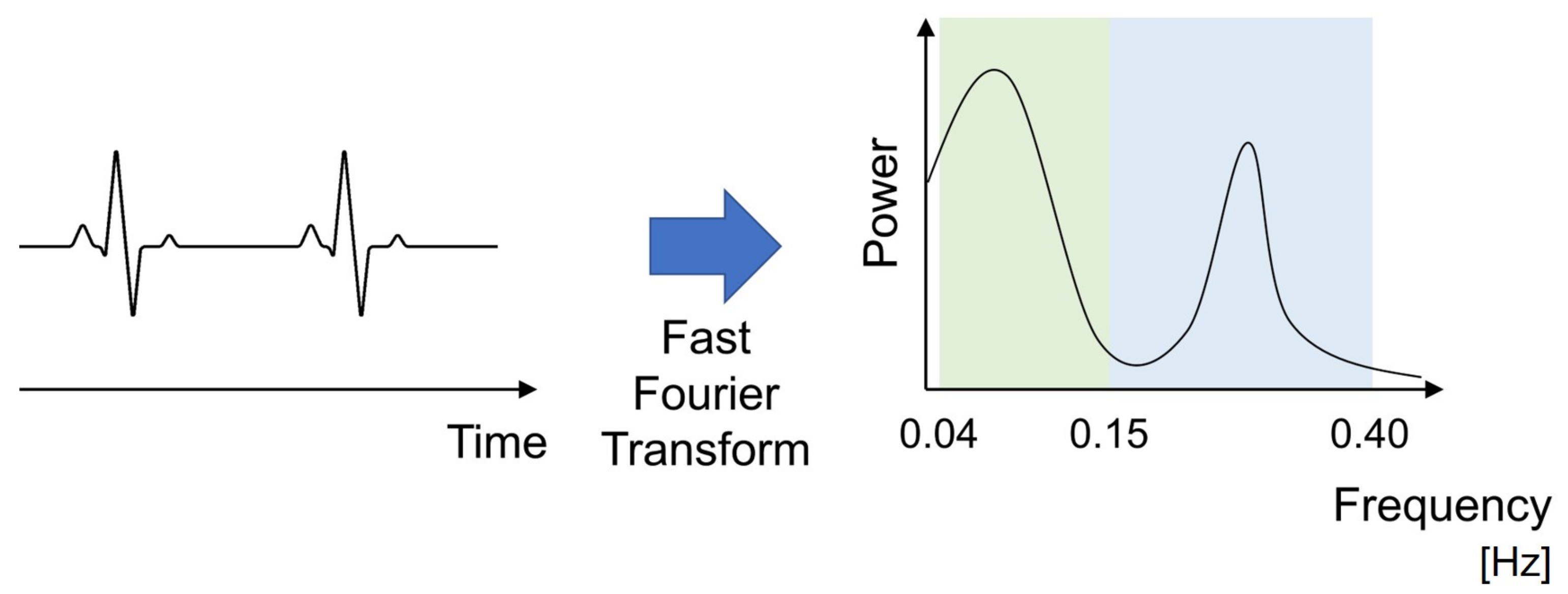
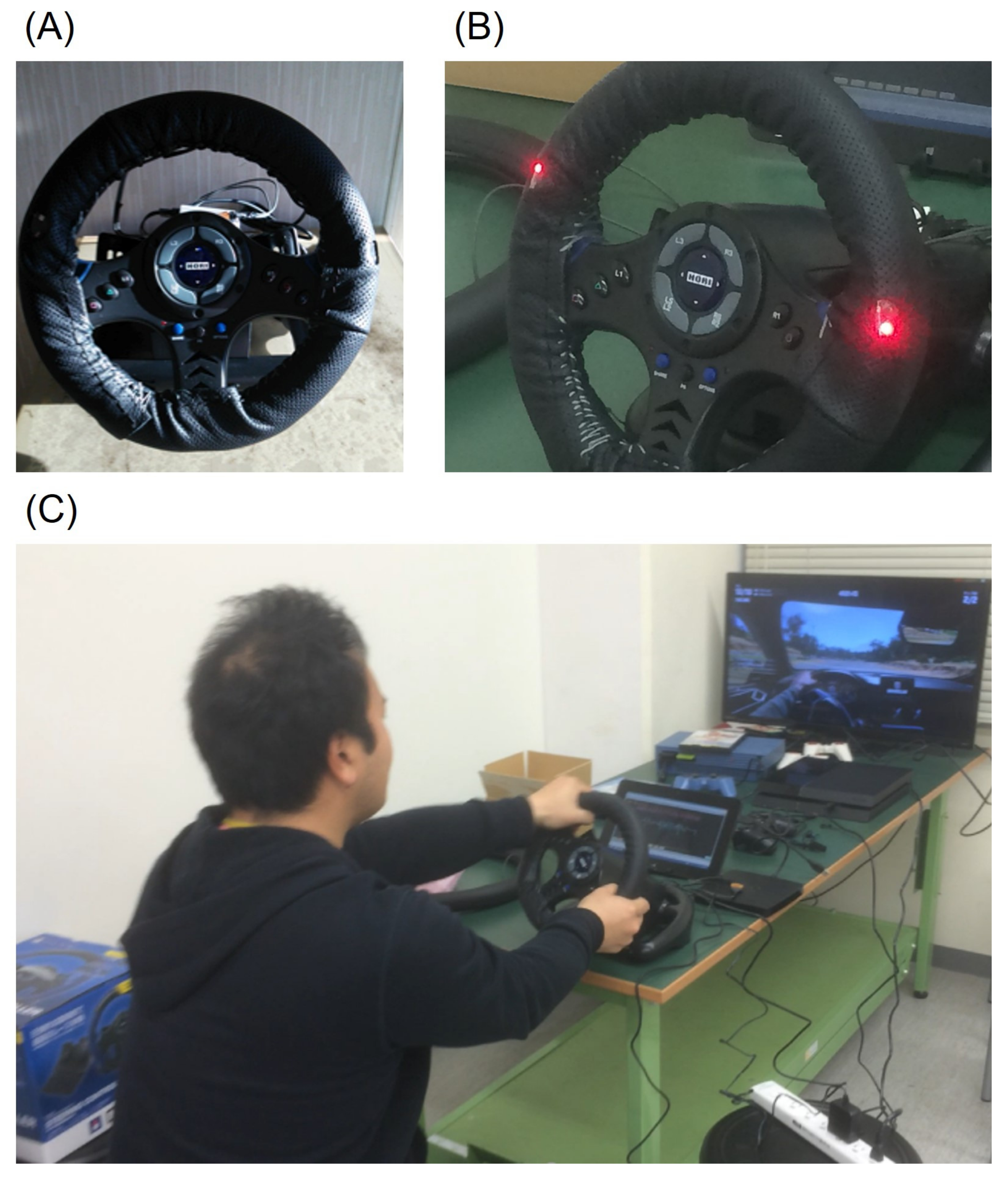
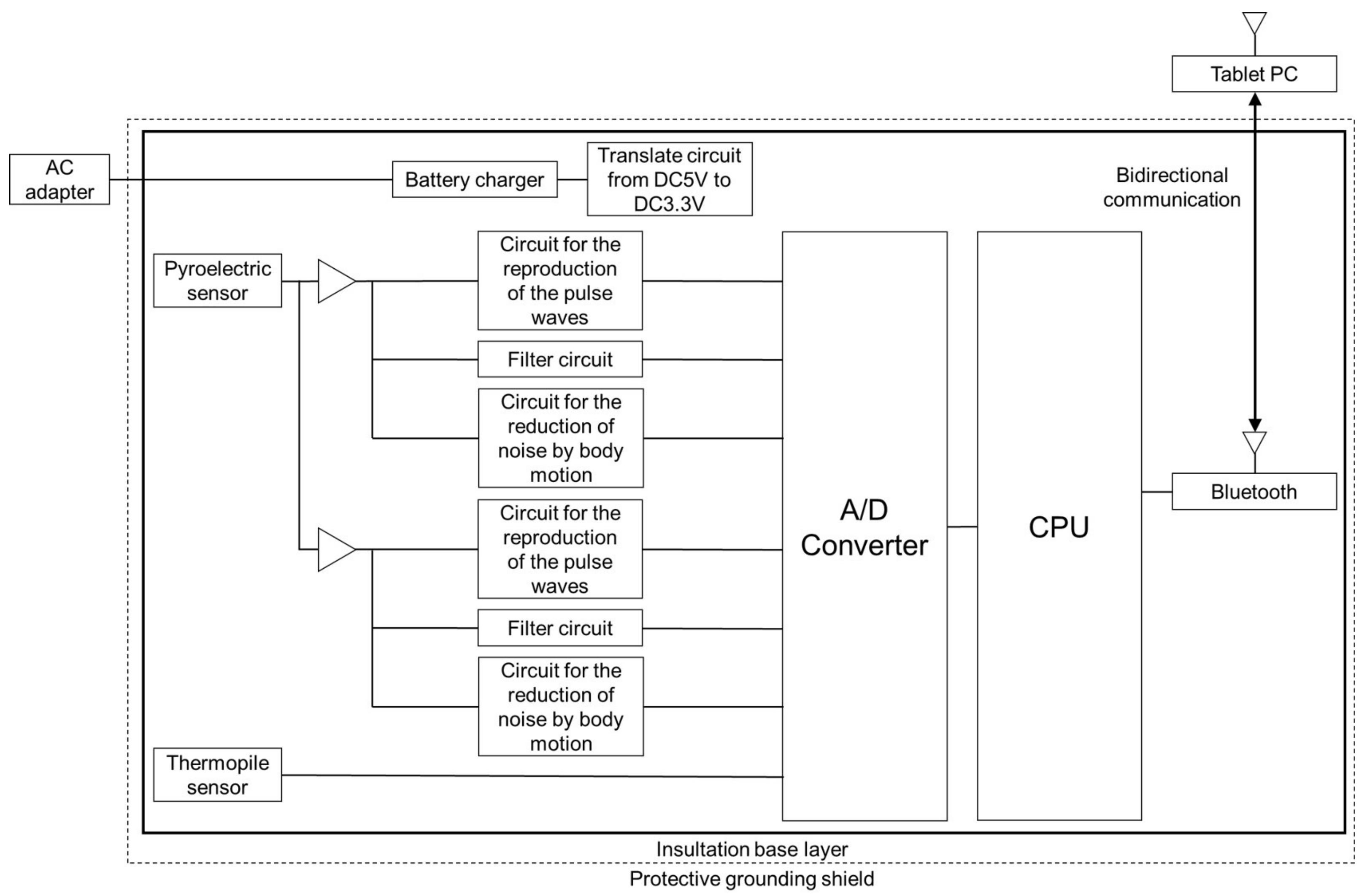
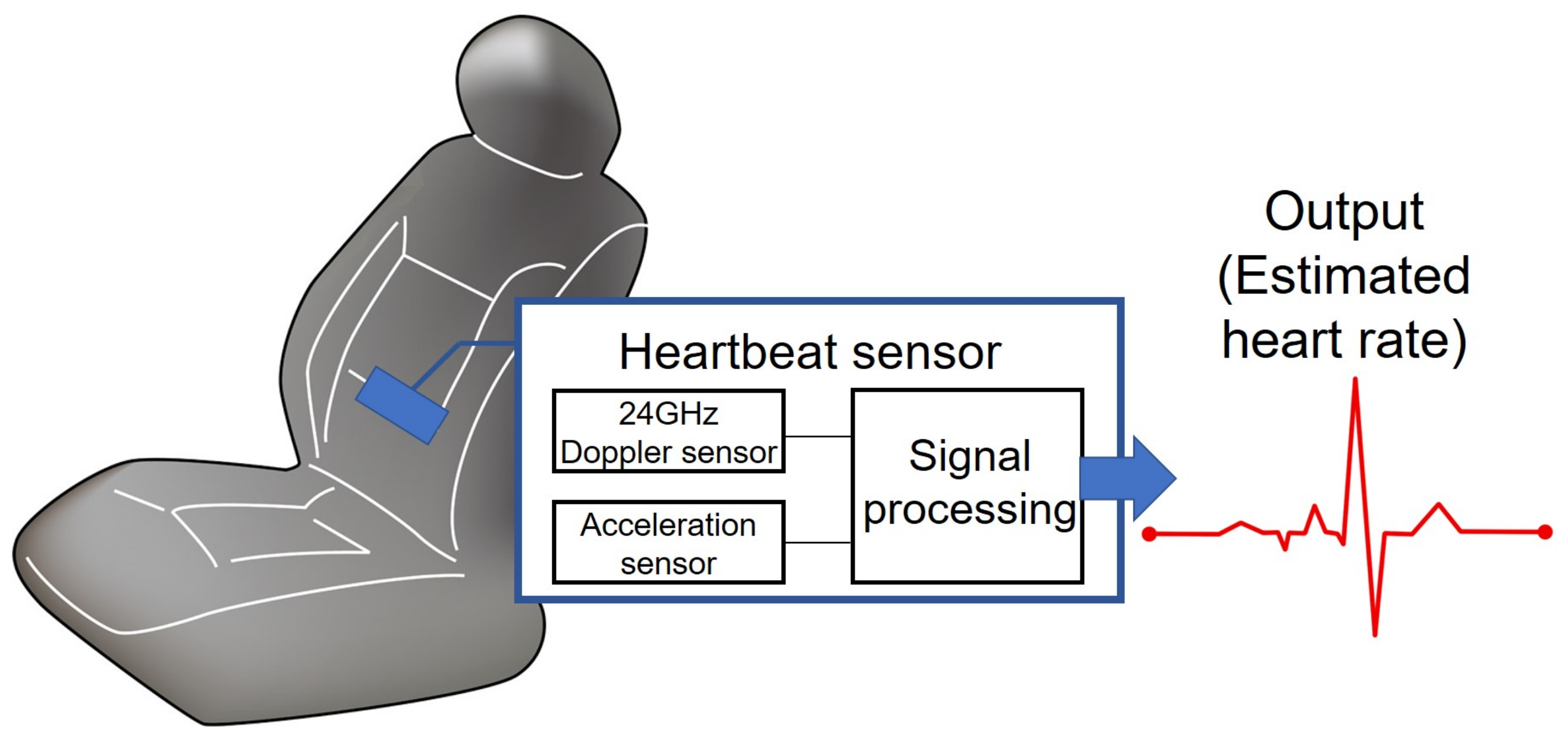
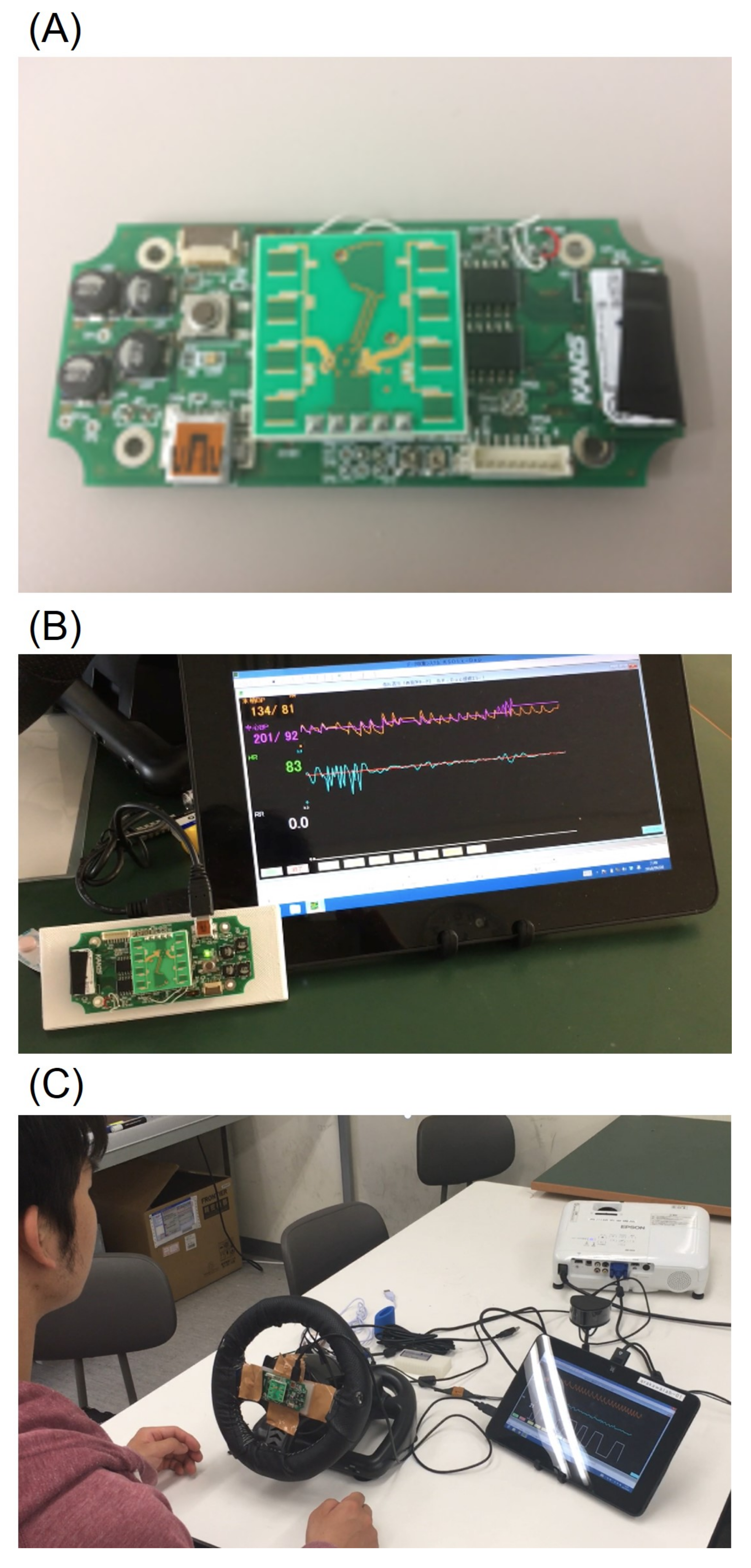
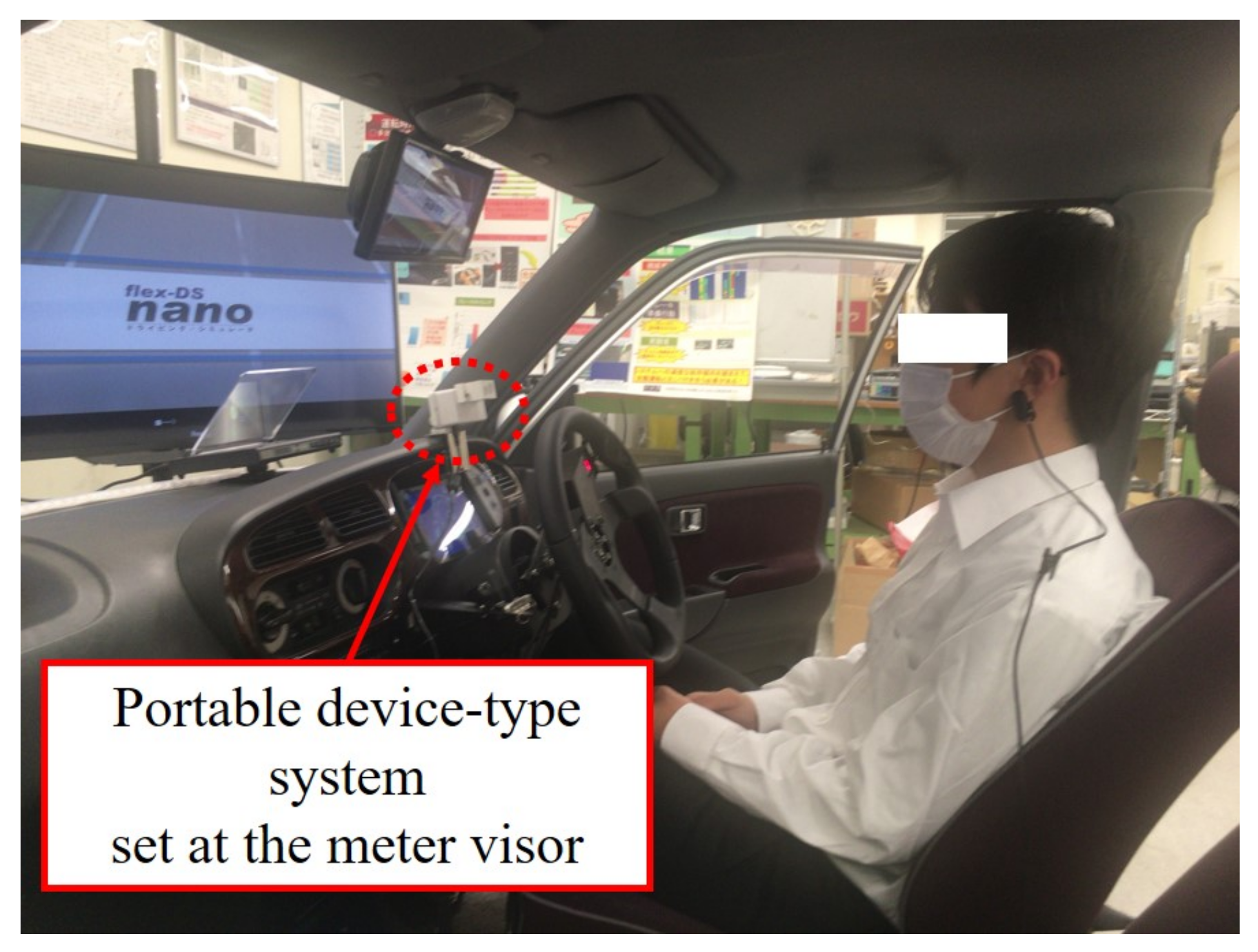
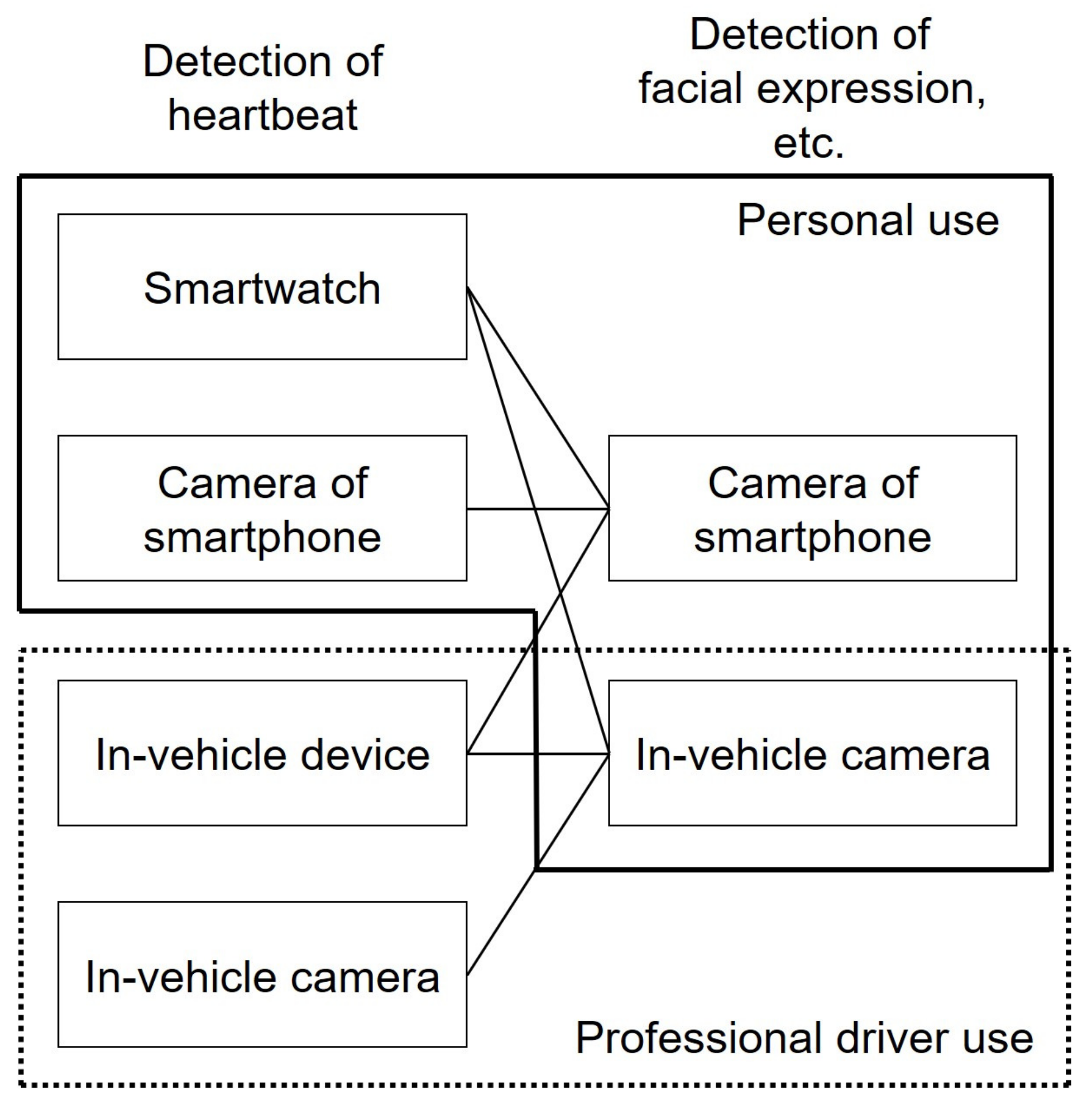
| Method | Technique | Device | Weak Point |
|---|---|---|---|
| ECG (Electrocar- diogram) | Measures the electrical pulses generated by the body during each cardiac cycle | Electrodes | Difficult to position correctly, affected by body movement, electrodes become loose when the body is sweaty |
| Sphygmomano- meter | A method for measuring changes in arterial pressure that vary with heart pulsation | Sphygmomano- meter | Affected by body movement |
| Cardiogram | Measure the sound generated by the pulsation of the heart | Finger, stethoscope, microphone | Affected by hand and finger movement |
| Photoelectric pulse | Near-infrared light is applied to the skin surface and the reflected light is received by a photodiode or other device | Smartwatch | Affected by body movement, touching condition of fingers, skins, etc. |
| Type of System | Measuring Methods |
|---|---|
| Wearable-type heartbeat measuring system | Wristwatch-type |
| Ring-type | |
| Necklace-type | |
| Shirt-type | |
| Nonwearable-type heartbeat measuring system | Steering-type |
| Seat-type | |
| Seatbelt-type | |
| Portable device-type | |
| Camera-type |
| Measuring Methods | Developers/ Authors | Year | Technology | Accuracy Compared to ECG |
|---|---|---|---|---|
| Wristwatch- type | Apple [31] Empatica [32] Garmin [33] Fitbit [34] Jawbone [35] | 2015 | Flashing a green LED light behind the watch several hundred times per second | Acceptable, 0.67 0.996 (during aerobic exercise) |
| Ring-type | Jung et al. [53] | 2007 | Flashing an LED light inside the ring several hundred times per second | NA |
| Oura [54] | 2016 | R2 = 0.996 for resting HR and R2 = 0.980 for HRV | ||
| TheTOUCH [55] | 2016 | NA | ||
| Necklace-type | Fujitsu [56] | 2015 | Wear the ear clip sensor on the ear to acquire vital data | NA |
| Shirt-type | Kasai et al. [57] | 2015 | Measure pulse waves by the electrode in the shirt | NA |
| Measuring Methods | Developers/ Authors | Year | Technology | Accuracy Compared to ECG |
|---|---|---|---|---|
| Steering- type | Yanagidaira and Yasushi [58] | 2003 | Measure by electrodes equipped onto the steering wheel | There is a correlation between HR change and subjective value of sleepness |
| Nakagawa et al. [59] | 2016 | NA | ||
| Arakawa et al. [60] | 2018 | Flashing an LED light equipped onto the steering wheel | The same level of performance as a commercial electronic sphygmomano- meter | |
| Seat-type | Mitani [63] | 2019 | Microwaves irradiated to the driver’s body and Doppler signals of the reflected waves | RMS error while driving is between 5 and 10 bpm |
| Murata et al. [64] | 2011 | Body-trunk plethysmogram signal detected by air-pack | NA(some say it is over 90%) | |
| Delta Kogyo [65] | 2012 | |||
| Seatbelt- type | HARKEN [68] | 2014 | Sensor embedded in the seat cover and the seatbelt | NA |
| Portable device-type | Texas instruments [69] | 2019 | Using Texas instruments mmWave sensors | High accuracy |
| Arakawa et al. [70,71] | 2017 | Infrared radar irradiated to the driver’s body and Doppler signals of the reflected waves | Not high accuracy due to body movement |
| Measuring Methods | Developers/ Authors | Year | Technology | Accuracy Compared to EEG |
|---|---|---|---|---|
| Camera- type | Sakamaki and Fujita [78] | 2020 | Signal processing of person’s skin image | BPM difference is less than 3 bpm |
| Okada et al. [79] | 2018 | Change in the average pixel value of the hemoglobin component images obtained using the skin pigment separation on the RGB pixel values of facial images | NA (only the accuracy of facial expression classification was evaluated) | |
| Kwon et al. [80] | 2012 | Facial color change took by a smartphone’s camera | NA | |
| Sun et al. [81] | 2018 | Facial color change took by RGB camera | ||
| Google [85] | 2014 | Pulsewave detected by smartphone’s camera | NA | |
| HRV4Training [86,87,88] | 2015 | MAPE, median and IQR of rMSSD is 4.10, 2.76 and 3.74, respectively | ||
| Huang [90] | 2016 | Facial color change took by smartphone’s camera | The mean of absolute errors of HRV metrics is 3.53 ms |
| Type of System | Measuring Methods | Advantages | Disadvantages |
|---|---|---|---|
| Wearable- type | Wristwatch-type | Accuracy seems to be guaranteed, easy to wear, many people have them and easy-to-use | Cannot measure if forget to wear, there are some unsolved problems such as recharging and the robustness of connectivity |
| Ring-type | Accuracy seems to be guaranteed, easy to wear | ||
| Necklace-type | |||
| Shirt-type | Discomfort to wear | ||
| Nonwearable- type | Steering-type | Not restrict the driver’s behavior, can measure at any time in spite of driver’s willing | Need to be installed at the time of purchase or after purchase the vehicle, |
| Seat-type | |||
| Seatbelt-type | |||
| Portable device-type | |||
| Camera-type | Accuracy in the cabin has not been fully evaluated |
Publisher’s Note: MDPI stays neutral with regard to jurisdictional claims in published maps and institutional affiliations. |
© 2021 by the author. Licensee MDPI, Basel, Switzerland. This article is an open access article distributed under the terms and conditions of the Creative Commons Attribution (CC BY) license (https://creativecommons.org/licenses/by/4.0/).
Share and Cite
Arakawa, T. A Review of Heartbeat Detection Systems for Automotive Applications. Sensors 2021, 21, 6112. https://doi.org/10.3390/s21186112
Arakawa T. A Review of Heartbeat Detection Systems for Automotive Applications. Sensors. 2021; 21(18):6112. https://doi.org/10.3390/s21186112
Chicago/Turabian StyleArakawa, Toshiya. 2021. "A Review of Heartbeat Detection Systems for Automotive Applications" Sensors 21, no. 18: 6112. https://doi.org/10.3390/s21186112
APA StyleArakawa, T. (2021). A Review of Heartbeat Detection Systems for Automotive Applications. Sensors, 21(18), 6112. https://doi.org/10.3390/s21186112






